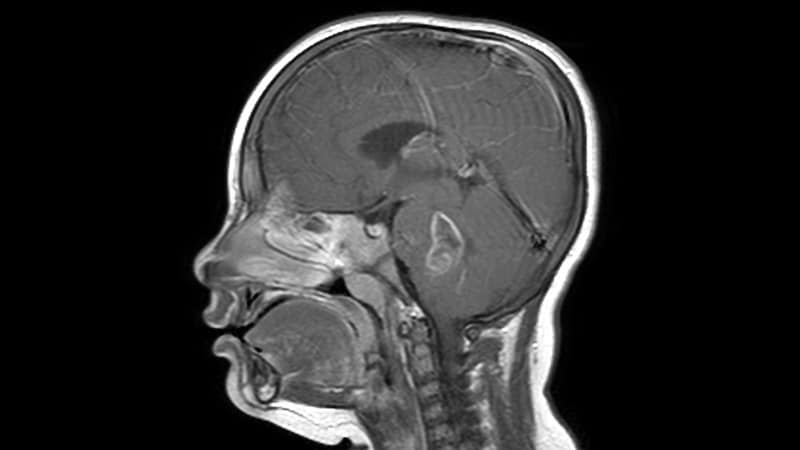CHICAGO —Targeted therapy achieved significantly higher responses rates and longer progression-free survival (PFS) when compared with standard chemotherapy in pediatric patients with BRAF V600-mutant low-grade gliomas, even those as young as 1 year of age.
The findings come from a phase 2 trial in pediatric patients (aged 1-18 years) which compared oral targeted therapy with dabrafenib (Tafinlar) plus trametinib (Mekinist) to intravenous chemotherapy with carboplatin and vincristine.
Targeted therapy showed a significant sevenfold increase in overall response rates vs chemotherapy, as well as a 69% improvement in PFS. It was also less toxic.
The results demonstrate the importance of early molecular testing in pediatric low-grade glioma and support the use of dabrafenib plus trametinib systemic treatment in BRAF V600-mutant patients requiring first systemic treatment, commented lead author Eric Bouffet, MD, professor of pediatrics, The Hospital for Sick Children, University of Toronto, Toronto, Canada.
This is “an important advance for the youngest patients with brain cancer, as this is the first combination of targeted therapies developed for patients as young as 1 year of age,” he added.
Bouffet presented the results here at the annual meeting of the American Society of Clinical Oncology.
Julie R. Gralow, MD, ASCO chief medical officer, commented to Medscape Medical News that the response and PFS findings are “pretty impressive.”
Moreover, the combination was “less toxic” than carboplatin plus vincristine, which “has been standard of care.”
“This study shows that a new, oral targeted therapy combination can significantly improve outcomes for the most common type of brain tumor in children over standard-of-care chemotherapy that often requires frequent visits to the hospital or clinic and can result in health problems later in life,” said Melissa M. Hudson, MD, an ASCO expert in pediatric cancers from St. Jude Children’s Research Hospital in Memphis, Tennessee.
Both she and the authors emphasized the important of testing the tumors of children with gliomas in order to find the 15%-20% of those with BRAF V600-mutations who may benefit from this targeted therapy.
Dabrafenib, a BRAF inhibitor, and trametinib, which targets the kinase MEK in the same signaling pathway, are both already on the market approved for use in BRAF-BRAF V600E or V600K mutation-positive melanoma.
Both drugs are available as oral tablets, but for this trial, Bouffet said a liquid formulation of dabrafenib plus trametinib was developed, which meant that “no child was left behind” in terms of being able to receive the treatment.
During the trial, the researchers had access to both the pill and the liquid formulations of the combination, and those patients who could not swallow the pills were able to receive the liquid formulation.
Trial Details
The trial enrolled 100 pediatric patients with histologically confirmed BRAF V600 mutation-positive low-grade glioma at 50 sites in 20 countries.
They were randomly assigned to dabrafenib plus trametinib or chemotherapy if they had progression following surgical excision or were nonsurgical candidates, and had no prior systemic or radiotherapy.
Those assigned to chemotherapy could cross over to the dabrafenib plus trametinib arm on progression.
The researchers assessed the overall response rate to treatment on central independent review using the Response Assessment in Neuro-Oncology (RANO) criteria, and found that that 47% of dabrafenib plus trametinib patients had a complete or partial response vs 11% of those given chemotherapy.
This translated into an odds ratio of an overall response with the combination vs chemotherapy of 7.2 (P < .001). Overall, the clinical benefit rate, which included stable disease, was 86% vs 46% with chemotherapy.
Independently assessed PFS was significantly longer with dabrafenib plus trametinib than with chemotherapy, at a median of 20.1 months vs 7.4 months, at a hazard ratio of 0.31 (P < .001).
Bouffet said that the overall survival data were currently “immature,” with no deaths among patients given dabrafenib plus trametinib at the data cutoff, and only one in the chemotherapy arm.
Although all patients experienced at least one adverse event, there were fewer grade 3 or higher events with dabrafenib plus trametinib than in the chemotherapy group, at 47% vs 94%, and fewer events leading to discontinuation, at 4% vs 18%.
The most common adverse events of any grade with dabrafenib plus trametinib were pyrexia (68%), headache (47%), and vomiting (34%).
He commented that the safety profile of the targeted therapy combination was “manageable and consistent” with what has been seen in adult populations.
Bouffet said that measurements of quality of life showed that patients receiving the combination treatment were stable and had a quality of life “close to normal,” meaning that they could continue go to school.
In contrast, patients receiving chemotherapy saw their quality of life gradually deteriorate.
The study will be continued to determine the optimal duration of dosing of dabrafenib plus trametinib.
The researchers also hope to establish if the combination is compatible with the World Health Organization global initiative for childhood cancer, as pediatric low-grade glioma is one of six diseases in the initiative.
Oral targeted therapies such as dabrafenib plus trametinib may have a huge impact in middle- and low-income countries, where the delivery of intravenous chemotherapy can be “impossible,” Bouffet said.
The study was funded by Novartis Pharmaceuticals Corp. Bouffet reports relationships with Novartis and Roche (Inst). Hudson reports relationships with Oncology Research, Information Exchange Network, and Princess Máxima Center. Gralow reports relationships with Genentech, AstraZeneca, Hexal, Puma BioTechnology, Roche, Novartis, Seagen, and Genomic Health.
American Society of Clinical Oncology (ASCO) 2022 Annual Meeting. Presented June 6, 2022. Abstract LBA2002.
For more from Medscape Oncology, follow us on Twitter: @MedscapeOnc
Source: Read Full Article
